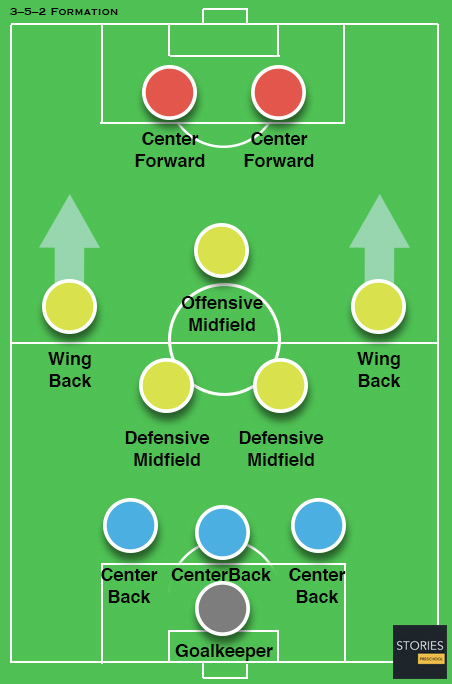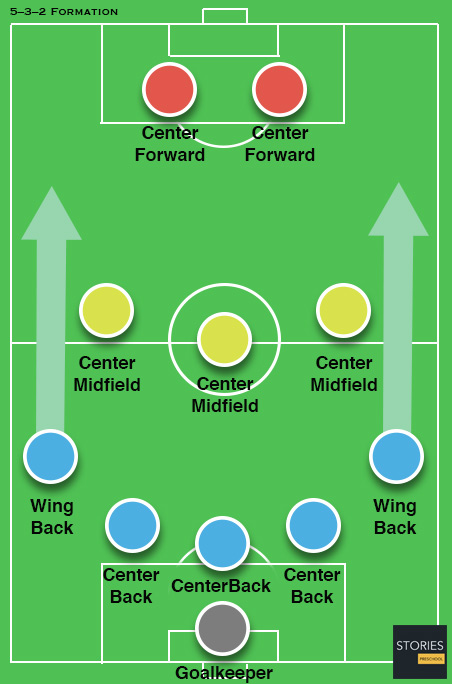Soccer

Wing-Back
The wing-back (or attacking full-back) are defenders with heavier emphasis on attack. The name is a portmanteau of "winger" and "full-back", indicating the greater emphasis on their responsibilities in attack. They are usually employed as part of a 3–5–2 formation, and can therefore be considered part of the midfield when a team is attacking. They may also be used in a 5–3–2 formation and therefore have a more defensive role. The term "wing-back" itself is gradually falling out of use as there is less of a distinction with the full-back roles in the modern game, especially when used in a 4–3–3 or 4–2–3–1 formation.


The wing-back role is one of the most physically demanding positions in modern football. Wing-backs are often more adventurous than traditional full-backs and are expected to provide width, especially in teams without wingers. A wing-back needs to be of exceptional stamina, be able to provide crosses upfield and then defend effectively against an opponent's attack down the flanks. A defensive midfielder is usually fielded to cover the advances of an opponent's wing-back.
-
Outline

SPORTS WORLD
Soccer | Football
The goalkeepers are the only players allowed to touch the ball with their hands or arms while it is in play and only in their penalty area. Outfield players mostly use their feet to strike or pass the ball, but may also use their head or torso to do so instead. The team that scores the most goals by the end of the match wins. The Laws of the Game are the codified rules that help define association football. They are the only rules of association football subscribed to by the sport's governing body FIFA.
Gameplay: Two teams of eleven players each compete to get the ball into the other team's goal (between the posts and under the bar), thereby scoring a goal. The team that has scored more goals at the end of the game is the winner; if both teams have scored an equal number of goals then the game is a draw.
Players: Each team consists of a maximum of eleven players (excluding substitutes), one of whom must be the goalkeeper.
Referee: Is the person responsible for enforcing the Laws of the Game during the course of a match.
Assistant referee: The assistant referee's duties generally consist of judging when the ball has left the field of play.
Equipment: The basic equipment or kit players are required to wear includes a shirt, shorts, socks, footwear and adequate shin guards.
Game duration: A standard adult football match consists of two periods of 45 minutes each, known as halves. Each half runs continuously, meaning that the clock is not stopped when the ball is out of play.
Misconduct (Foul): Fouls and misconduct in football/soccer are acts committed by players which are deemed by the referee to be unfair and are subsequently penalized.
Positions: A team is made up of one goalkeeper and ten outfield players who fill various defensive, midfield, and attacking positions depending on the formation deployed.
Player styles: Most players will play in a limited range of positions throughout their career, as each position requires a particular set of skills and physical attributes.
Formations: The formation describes how the players in a team are positioned on the pitch. Different formations can be used depending on whether a team wishes to play more attacking or defensive football.
Tactics and skills: Well-organized and well-prepared teams are often seen beating teams with supposedly more skillful players, even over time.
Advanced skills: There are various individual skills and team tactics needed to play effective football.
-
Team Positions
SPORTS WORLD
Team Positions
In the sport, each of the 11 players on a team is assigned to a particular position on the field of play. A team is made up of one goalkeeper and ten outfield players who fill various defensive, midfield, and attacking positions depending on the formation deployed. These positions describe both the player's main role and their area of operation on the pitch.
Goalkeeper: Goalkeeper, often shortened to keeper or goalie, is one of the major positions of association football.
Centre-back: The job of the centre-back is to stop opposing players, particularly the strikers, from scoring, and to bring the ball out from their penalty area.
Sweeper: The sweeper is a defensive position in football, so called because their job is to 'sweep up' any attacking moves which pass other defenders.
Full-back: The full-backs take up the holding wide positions and traditionally stayed in defense at all times, until a set-piece.
Wing-back: The wing-back (or attacking full-back) are defenders with heavier emphasis on attack.
Centre midfield: Central midfielders provide a link between defense and attack, fulfilling a number of duties and operating primarily in the middle third of the pitch.
Defensive midfield: A defensive midfielder is a central midfielder who is stationed in front of the defenders to provide more defensive protection, thus "holding back" when the rest of the midfield supports the attack.
Attacking midfield: An attacking midfielder is a midfield player who is positioned in an advanced midfield position, usually between central midfield and the team's forwards, and who has a primarily offensive role.
Wide midfield: Is a midfielder who is stationed to the left or right of central midfield.
Centre forward: A centre forward (main striker) has the key task of scoring goals and for this reason acts as the focal point of the majority of attacking play by a team.
Second striker: They are required to be more "nippy", quick, mobile, and skillful, helping to create goals and scoring opportunities for centre forwards.
Winger: Is an attacking player who is stationed in a wide position near the touchlines.

Soccer | Football
The goalkeepers are the only players allowed to touch the ball with their hands or arms while it is in play and only in their penalty area. Outfield players mostly use their feet to strike or pass the ball, but may also use their head or torso to do so instead. The team that scores the most goals by the end of the match wins.
The Laws of the Game are the codified rules that help define association football. They are the only rules of association football subscribed to by the sport's governing body FIFA.
- Gameplay
- Players
- Referee
- Assistant referee
- Equipment
- Game duration
- Misconduct (Foul)
- Positions
- Player styles
- Formations
- Tactics and skills
- Advanced skills
Team Positions
Defender
Midfielder
Forward








RESOURCES
This article uses material from the Wikipedia articles "Association football" and "Association football positions", which is released under the Creative Commons Attribution-Share-Alike License 3.0.
© Stories Preschool. All Rights Reserved.
"Building Cool Educational Stuff for children and adults!"


Historic Battles
Wars and military campaigns are guided by strategy, whereas battles take place on a level of planning and execution known as operational mobility.
View Historic Battles »


Historic People
A historical figure is a famous person in history, such as Alexander the Great, Admiral Yi Sun-Shin, Abraham Lincoln, George Washington, Christopher Columbus, or Napoleon Bonaparte.
View Historic People »


Historic Timeline
Describes the history of humanity as determined by the study of archaeological and written records. Ancient recorded history begins with the invention of writing.
View Historic Timeline »

Historic Legends
Beings in myths are generally gods and goddesses, heroes and heroines, or animals and plants. Most myths are set in a timeless past before recorded time or beginning of the critical history.
View Historic Legends »

Sports World
Includes competitive games which, through casual or organized participation, aim to use, maintain or improve physical ability and skills while providing enjoyment to participants.
View Sports World »

Untold Stories
If you have any questions, feedback or suggestions for us, we'd like to hear from you. Please feel free to contact us!
Contact Us

Historic Battles
Wars and military campaigns are guided by strategy, whereas battles take place on a level of planning and execution known as operational mobility.
View Historic Battles »

Historic People
A historical figure is a famous person in history, such as Alexander the Great, Admiral Yi Sun-Shin, Abraham Lincoln, George Washington, Christopher Columbus, or Napoleon Bonaparte.
View Historic People »

Historic Timeline
Describes the history of humanity as determined by the study of archaeological and written records. Ancient recorded history begins with the invention of writing.
View Historic Timeline »

Historic Legends
Beings in myths are generally gods and goddesses, heroes and heroines, or animals and plants. Most myths are set in a timeless past before recorded time or beginning of the critical history.
View Historic Legends »

Sports World
Includes competitive games which, through casual or organized participation, aim to use, maintain or improve physical ability and skills while providing enjoyment to participants.
View Sports World »

Untold Stories
If you have any questions, feedback or suggestions for us, we'd like to hear from you. Please feel free to contact us!
Contact Us
Historic Battles
Wars and military campaigns are guided by strategy, whereas battles take place on a level of planning and execution known as operational mobility.
View Historic Battles »

Historic People
A historical figure is a famous person in history, such as Alexander the Great, Admiral Yi Sun-Shin, Abraham Lincoln, George Washington, Christopher Columbus, or Napoleon Bonaparte.
View Historic People »

Historic Timeline
Describes the history of humanity as determined by the study of archaeological and written records. Ancient recorded history begins with the invention of writing.
View Historic Timeline »

Historic Legends
Beings in myths are generally gods and goddesses, heroes and heroines, or animals and plants. Most myths are set in a timeless past before recorded time or beginning of the critical history.
View Historic Legends »

Sports World
Includes competitive games which, through casual or organized participation, aim to use, maintain or improve physical ability and skills while providing enjoyment to participants.
View Sports World »

Untold Stories
If you have any questions, feedback or suggestions for us, we'd like to hear from you. Please feel free to contact us!
Contact Us